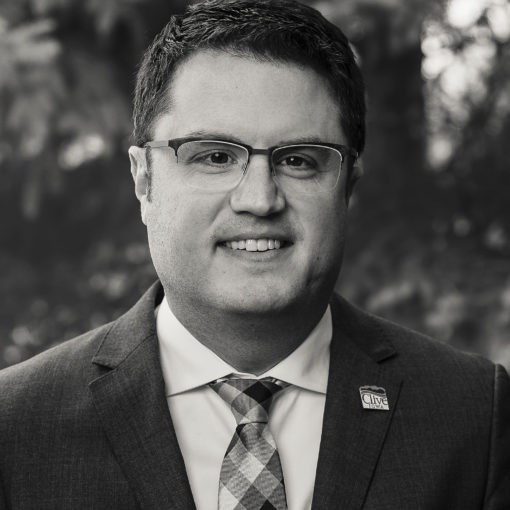
Jay Byers | CEO, Greater Des Moines Partnership
The Idea: Unleash the full recreational capacity of our rivers and fulfill the vision of the Riverwalk, by once again stepping up to a challenge and funding and executing the water trails plan.
Des Moines was founded as a city because of its strategic location at the confluence of the Des Moines and Raccoon rivers. From Native American tribes to the establishment of Fort Des Moines in the mid-1800s to today, our region’s history, and now our future, is directly connected to our rivers.
Throughout the years, significant investments have been made to enhance the riverfront. From the late 1800s through the early 1900s, Des Moines undertook a “City Beautiful” project in which a number of large public buildings, including the current City Hall, were constructed in the beaux-arts style along the Des Moines River. The ornate riverfront walls and railings that line the downtown riverfront were built by the federal Civilian Conservation Corps in the mid-1930s.
In 2002, Principal launched the Principal Riverwalk to celebrate its 125th anniversary and to help bring the downtown riverfront back to life. This project, in partnership with the city of Des Moines and a wide range of other partners, resulted in public and private investments of more than $70 million and included a multiuse trail loop that connects the two sides of the river, two signature pedestrian bridges, Brenton Skating Plaza, the Hub Spot, public art, plazas, gardens and much more.
Even with these investments and many others, Downtown Des Moines has more capacity to maximize the full vision of the Principal Riverwalk that included increasing boat access and other recreational uses by removing the dangers associated with the existing low-head dams. In fact, our region as a whole needs more recreational access and connectivity within our extensive network of rivers and streams. We now have the opportunity to unleash the full recreational capacity of our rivers and fulfill the vision of the Riverwalk.
The Greater Des Moines Water Trails and Greenways Master Plan, which is supported by a wide range of public, private and nonprofit organizations, envisions an extensive network of water recreation for 150 miles of our region’s creeks and rivers. The plan features three signature dam mitigation projects that will bring top-tier whitewater rafting, kayaking, canoeing, surfing, fishing, birding and other recreational opportunities to the Des Moines and Raccoon rivers in downtown Des Moines. An adventure park on the riverfront could include zip lining and a climbing wall, complementing the Lauridsen Skatepark.
The preliminary engineering study on the $117 million plan is complete, and the funding feasibility and economic impact studies continue to advance. Regional water trails projects in Johnston and West Des Moines are already moving forward, and the Lauridsen Skatepark construction is underway with completion scheduled for next year.
The Greater Des Moines Water Trails and GreenwaysMaster Plan will be the region’s most transformational quality of life project of our generation. It will be a game-changer that will help attract and retain top talent and give Greater Des Moines another competitive edge. It will help increase tourism and retail sales, create new businesses and jobs, and attract new investment to our region as similarriver activation projects have already done in places such as Columbus, Ga., Boise, Idaho, and Munich, Germany.
Completing this project will not be easy. It will take strong leadership. It will take cooperation and coordination among many organizations throughout our community. It will take significant funding. And it will take a lot of hard work and grit. Fortunately, our region has a rich history of public, private and nonprofit leaders coming together to complete major projects of this magnitude. Building on this tradition, we must once again step up to the challenge and get this project done. It is our collective responsibility to activate our rivers.
The rivers have defined our past. Now we can let them help us define our future. >




